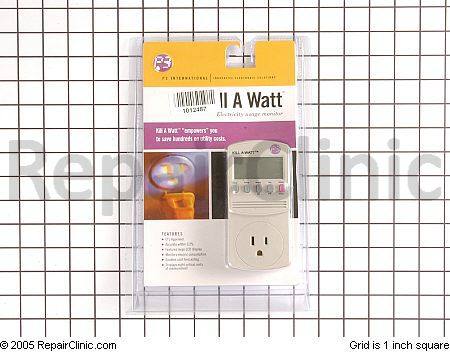Lots of folks today are struggling to save shekels in this broke-back economy and that’s ezzacly why the Samurai’s here. One budget item that many households don’t have a good handle on is the electric bill. With just a little information from the appliance name plate and some third-grade math using a calcumulator, the Samurai’s gonna show you how to quickly and easily figger out how much electricity each of your appliances, large and small, are using.
Just like in a budget, you usually can’t point to any one item and say, “Aha! There’s the big money drainer!” Instead, it’s usually a process of “death by a thousand cuts”– trimming a few pennies here and a few pennies there and, next thing you know, you’ve saved some real money.
Wattage
Watts are the basic unit of power use and consumption. You can usually find the wattage of most appliances stamped on the bottom or back of the appliance, or on its nameplate. The wattage stamped on the appliance is the maximum power drawn by the appliance.
Kilowatts are just watts x 1000. Your power meter actually measures kilowatts over a period of time, called kilowatt-hours (abbreviated kWh). This is simply the amount of kilowatts your home is sucking off the grid times the number of hours. This is the sum total of all electricity usage going in your home at any given time.
Since many appliances have a range of settings (for example, the speed of a washing machine spin or the heat setting on a dryer), the actual amount of power consumed depends on the actual setting used when you run the appliance.
All this will become clear when we work through some ezzamples so hang with me…
Special note for refrigerators: For older models, you can estimate the number of hours that a refrigerator actually operates at its maximum wattage by dividing the total time the refrigerator is plugged in by three. Even though it’s “turned on” all the time, the refrigerator compressor actually cycles on and off as needed to maintain interior temperatures.
Newer refrigerators with the variable capacity compressors (VCC) are a little different. They’ll actually vary the speed at which the compressor runs which affects its power consumption. In theory, this reduces the power consumption so if you used the “divide by three” method, you’ll come up with a higher power consumption than it’s actually using.
One solution for finding the power consumption on these newer refrigerators is to use the Kitt-a-Watt meter (discussed below) to directly measure the refrigerator’s power usage.
Formula for Estimating Energy Consumption
Let’s start with some third-grade math. Here’s a simple way to estimate appliance energy consumption.
(Wattage × Hours Used Per Day) / 1000 = Daily Kilowatt-hour (kWh) consumption
Now, multiply this by the number of days you use the appliance during the year for the annual consumption. You can then calculate the annual cost to run an appliance by multiplying the kWh per year by your local utility’s rate (on your power bill) per kWh consumed.
Now for those promised examples:
Window fan:
Suppose you have a window fan that has a watt rating of 200 watts stamped on its nameplate and you use it four hours/day about four months out of the year. And suppose your power rate is 8.5 cents/kWh (this is pretty cheap power, BTW– up here in Yankeeland, we pay over 18 cents/kWh! The rate will vary widely– check your power bill for your actual rate). Let’s see how much that sucker’s costing you:
(200 Watts × 4 hours/day × 120 days/year) / 1000
= 96 kWh × 8.5 cents/kWh
= $8.16/year
Easy as pie, da tovarish?
Let’s tackle another one…
Personal Computer and Monitor:
Suppose the compooter on your desktop has a wattage rating of 120 watts stamped on its nameplate or somewhere in the manufacturer’s tech specs. Let’s also suppose the monitor you’re using to read this web page has a rating of 150 watts and you use your compooter about four hours per day, year ’round. Again, we’re just using the power rate of 8.5 cents/kWh for an example. So how much is that costing you?
(120 + 150 Watts × 4 hours/day × 365 days/year) / 1000
= 394 kWh × 8.5 cents/kWh
= $33.51/year
Sometimes, the wattage isn’t stamped on the appliance and they might only give the amps instead. Amps is a measure of the electric current draw; it’s a measure of flow like gallons per minute from the BP oil gusher, same idea.
If the wattage is not listed on the appliance, you can still estimate it by finding the current draw (in amperes) and multiplying that by the voltage used by the appliance. Most appliances in the United States use 120 volts AC (vac). Larger appliances, such as electric clothes dryers and electric cooktops, use 240 vac (gas clothes dryers use 120 vac).
If the amps aren’t stamped on the appliance anywhere, you can easily measure it with a nifty and inexpensive gadget called a Kill-a-Watt meter. You just plug the Kill-a-Watt into the wall, then plug the appliance into the Kill-a-Watt meter and you’ll read the amps, watts, and volts right on the meter. No fuss, no muss! Come git you one:
Typical Wattages for Appliances
For rough estimate purposes, here are some typical wattages of various household appliances.
Aquarium = 50–1210 Watts
Clock radio = 10
Coffee maker = 900–1200
Clothes washer = 350–500
Clothes dryer = 1800–5000
Dishwasher = 1200–2400
Dehumidifier = 785
Electric blanket- Single/Double = 60 / 100
Fans
– Ceiling = 65–175
– Window = 55–250
– Furnace = 750
– Whole house = 240–750
Hair dryer = 1200–1875
Heater (portable) = 750–1500
Clothes iron = 1000–1800
Microwave oven = 750–1100
Personal computer
– CPU – awake / asleep = 120 / 30 or less
– Monitor – awake / asleep = 150 / 30 or less
– Laptop = 50
Radio (stereo) = 70–400
Refrigerator (frost-free, 16 cubic feet) = 725
Televisions (color)
– 19″ = 65–110
– 27″ = 113
– 36″ = 133
– 53″-61″ Projection = 170
– Flat screen = 120
Toaster = 800–1400
Toaster oven = 1225
VCR/DVD = 17–21 / 20–25
Vacuum cleaner = 1000–1440
Water heater (40 gallon) = 4500–5500
Water pump (deep well) = 250–1100
Water bed (with heater, no cover) = 120–380


